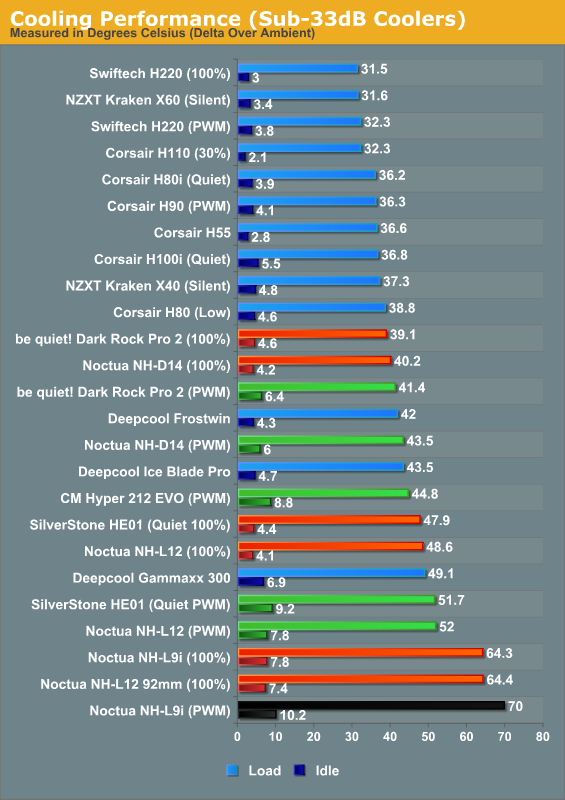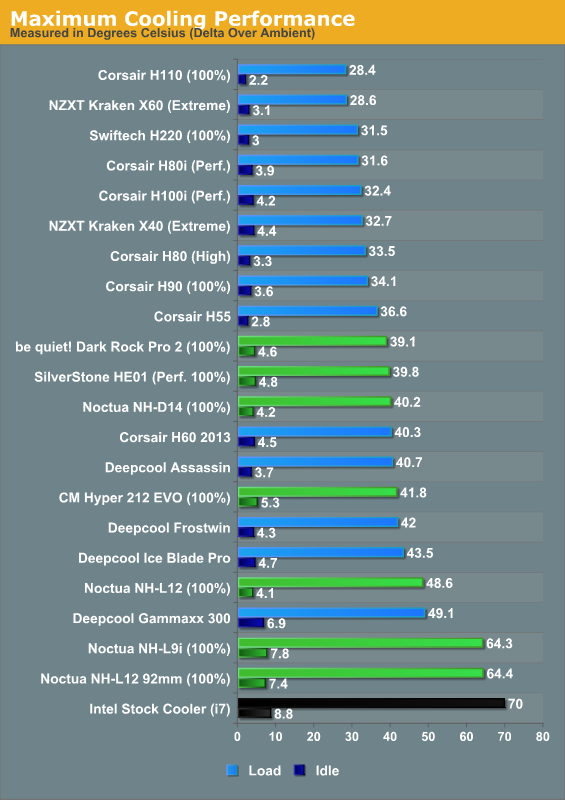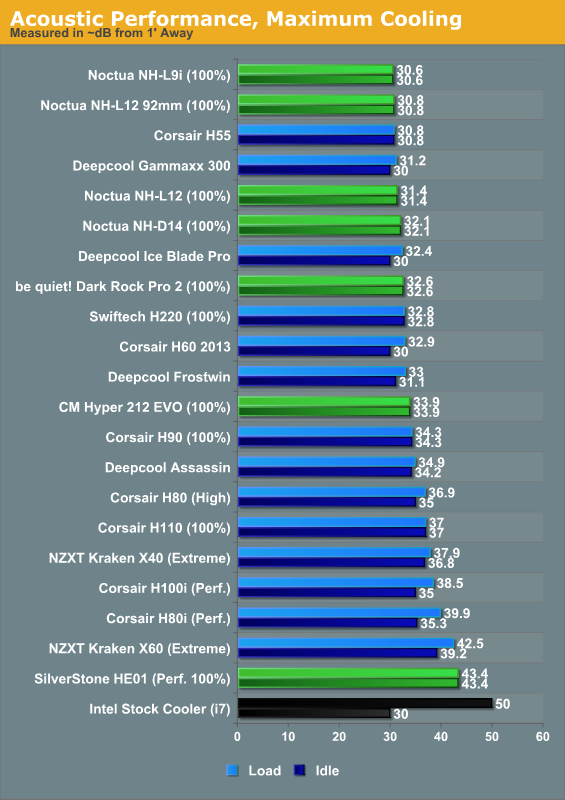CPU Air Cooler Roundup: Six Coolers from Noctua, SilverStone, be quiet!, and Cooler Master
by Dustin Sklavos on March 14, 2013 2:40 AM EST- Posted in
- Cases/Cooling/PSUs
- Cooler Master
- SilverStone
- cooling
- Noctua
- be
Silent Cooling Performance and Absolute Performance
Testing cases is in some ways much simpler than testing coolers, and a large part of that is because outside of an integrated fan controller, there's really not as much variability in the case's stock performance. Coolers, on the other hand, immediately benefit from the motherboard's fan control, and that has to be taken into account. They also have a more direct effect on the CPU's overall thermal performance. That means we need to break down the results into more useful metrics.
The first one is for silent performance. As a noise cap, I've chosen 33dB. Any coolers or settings that resulted in idle or load noise above 33dB have been pruned from the chart.

While every cooler I've tested today makes an appearance on this chart, the closed loop liquid coolers unfortunately have a clear advantage here. These are all quality units using excellent fans, though, and I'm keen to point out that you have to go to a 240mm or 280mm radiator before the closed loop units take a decisive lead. Generally speaking, you can get close to a 120mm or 140mm closed loop's cooling potential in an air cooler with comparable noise levels.
I'm keen to point out that Cooler Master's inexpensive Hyper 212 EVO actually does put in a pretty good showing here. Users on a budget would do well to note that it actually beats SilverStone's much larger Heligon HE01 when the Heligon's fan isn't cranked up.
With silent cooling broken down, let's take a look at the absolute maximum performance that can be gleaned from the coolers we've tested so far.

As it turns out, the closed loop coolers have a bit more headroom left in them compared to the majority of the air coolers tested. Our top performing trio is pretty much neck and neck for thermal performance, and even the Cooler Master Hyper 212 EVO is able to get awfully close to them. If you want high end air performance, you can definitely have it at a good price.

Of our big winners, though, Noctua and be quiet!'s solutions prove to be the quietest. SilverStone's Heligon may be able to produce comparable thermals, but that 38mm thick fan has to do an awful lot of grunt work to get there.










63 Comments
View All Comments
extide - Thursday, March 14, 2013 - link
How do you measure thermal efficiency? Just by how cool it gets the cpu? If so then CLC's do well.Noise wise, has a lot to do with the fans and can be very similar to other coolers.
Cost? They are a bit expensive but their ability to cool well and also exhaust heat directly out the case is typically enough justification. I mean we are only talking about maybe $20 max, far less than a tank of gas even.
Reliability? I have had two in service for quite a while now and they have been fine but I can see how adding a pump into the mix is a recipe for lowering overall reliability potential.
However the simple fact is water moves heat better than heat-pipes, period. So you can move heat to a larger radiator, and also put that radiator in a larger variety of places. That is why even the small closed loop coolers do well. I have built several full custom loops in the past, and the closed loop coolers are not nearly as good as a high end custom setup, but FAR easier to get going and little to not maintenance. They have their place IMHO. They are not perfect but they definitely have their place.
Do you have any facts or reasons behind your statement or are you just saying stuff because it sounds cool? Maybe your idea of technically astute is incorrect, or you are simply not technically astute yourself.
cjs150 - Thursday, March 14, 2013 - link
Of course there is the downside to water coolers. They are spot not area coolers. Air will cool everything (to a certain extent) in the case as it flows over it, water will only cool those spots which have a waterblock.That is why you need to have decent airflow in a watercooled case - if not you fry the RAM (and yes I have done that)
DanNeely - Thursday, March 14, 2013 - link
A few years ago I saw a CPU waterblock by a low-tier vendor that had brackets for a down blowing fan on top to keep the ram/mosfets from baking; and have always wondered why none of the other vendors have ever offered anything similar.mevans336 - Thursday, March 14, 2013 - link
I would love it if there were a way for the noise to be recorded so we can listen. Sure dBA numbers are great, but the actual pitch of the sound emitted is very important. I also have a hard time translating dBA numbers into perceived sound increase. I have a Noctua NH-D14 and according to your charts, there is only a 2dBA increase from silent to 100%. I would have guessed it to be MUCH larger than that as the perceptible sound increase from silent to 100% in my rig is massive. The pitch/tone of the sound (if that's the right terminology) at 100% changes drastically too.kmi187 - Thursday, March 14, 2013 - link
Here in Europe the DarkRock Pro is typically 1 to 2 euro's cheaper than the Noctua NH-D14, sometimes a bit cheaper even, if you can be bothered to look around. The new BeQuiet Shadow Rock also performs quite well imho, haven't used it myself but it's the cooler we put in budget systems at the shop whenever coolermaster EVO's aren't available.IanCutress - Thursday, March 14, 2013 - link
We used the original Dark Rock Pro for an ASUS S2011 contest early last year, and it was quickly overwhelmed by the heat generated from the CPU past 5 GHz. So much that we had to force extra pressure on the socket so the processor didn't downclock and bork the scores.lwatcdr - Thursday, March 14, 2013 - link
Good review. The only thing I would suggest would be to also use a test bench for testing the coolers so you can take the case out of the equation. I would still test in a case as well but pick one you really like to build in because you will need to do it forever. Of course maybe you have.Now you just need to test every cooler in every case and with every CPU. Can you have it by next week?
wongwarren - Thursday, March 14, 2013 - link
No sorry the Plus' fan is better than the Evo's fan.lichoblack - Thursday, March 14, 2013 - link
What about comparing low-profile coolers with some CLC's? Given the new trend towards smaller cases, and the height restriction of those microATX (Thermaltake LANBox for instance) or microITX cases (a LianLi one has 38mm height restriction, fitting for the noctua reviewed here) it would be interesting to compare a CLC to a compact cooler that has to be smaller than, say 100mm height.shaolin95 - Thursday, March 14, 2013 - link
Good stuff. I hope you add the Thermaltake Water 2.0 extreme to the mix.I moved from D14 to it and love it.